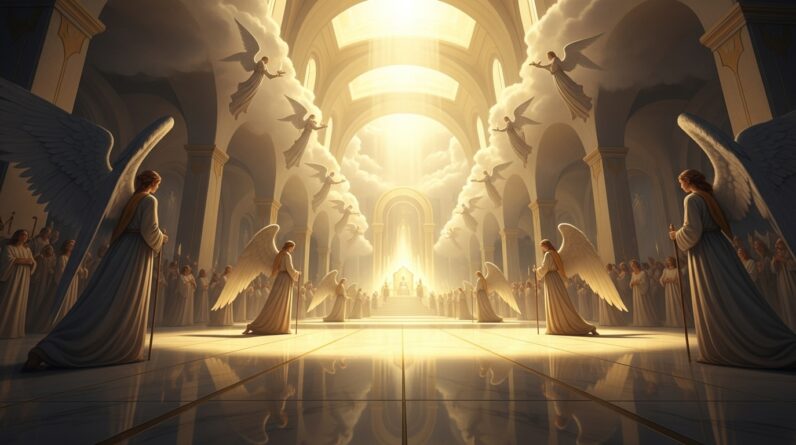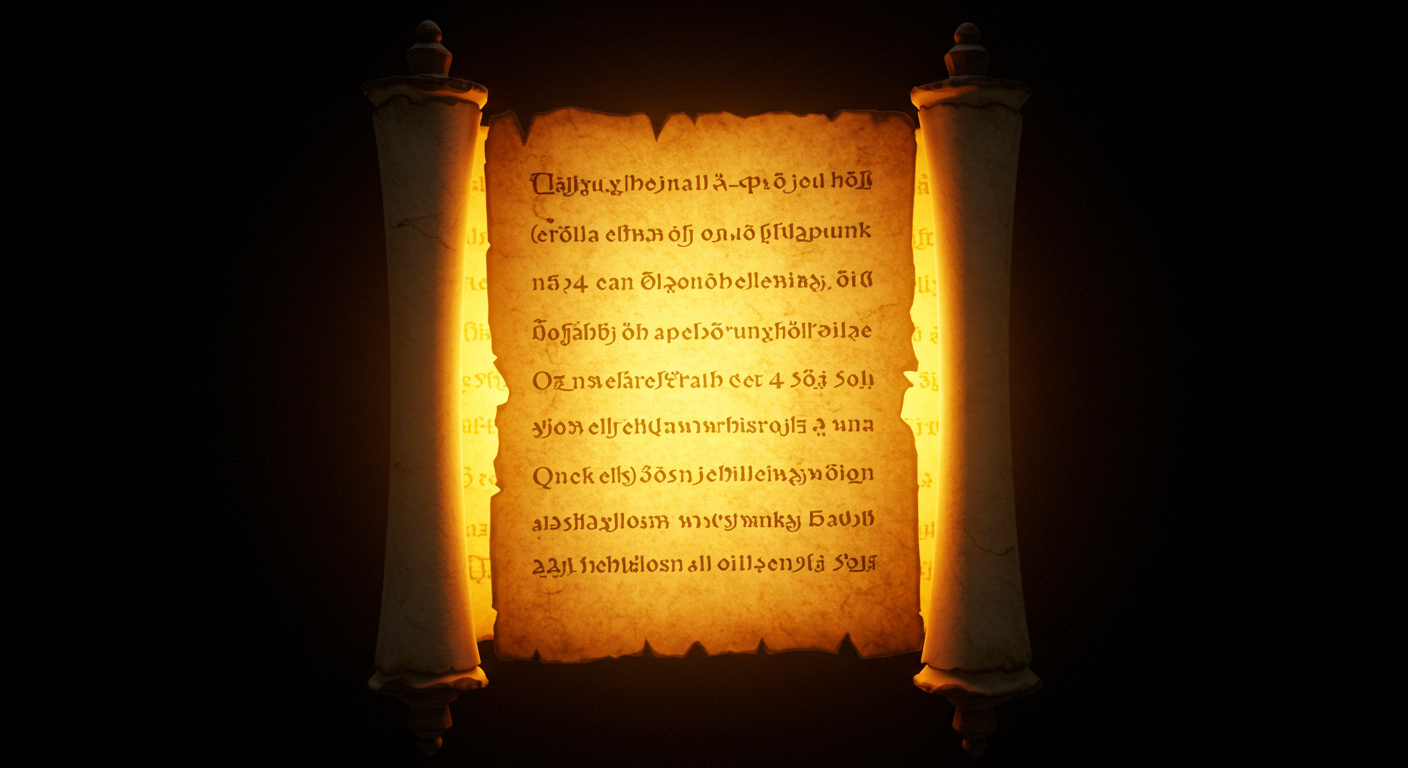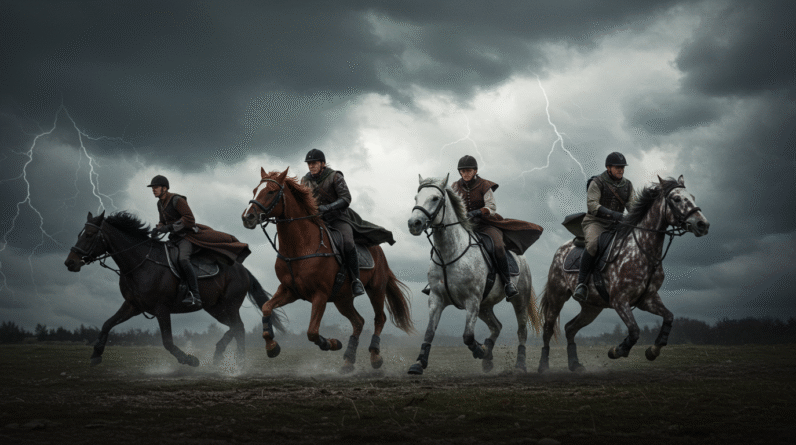the subject.
The Four Horsemen Of The Apocalypse Explained
When you open Revelation and encounter the riders on four horses, you step into some of the Bible’s most vivid and challenging imagery. The prophecy in Revelation 6 paints a picture that has captured imaginations for centuries and raised urgent questions: What do these riders mean? Are they literal events, symbolic forces, or something in between? In this article, you’ll get a careful, pastoral walk-through of the four horsemen of the apocalypse, the biblical text that introduces them, and the major ways Christians have understood them through history. As you read, you’ll find practical reflections for faith, hope, and how to live in light of prophetic warnings.
What you’re about to read
You’ll be guided verse-by-verse through the opening of the seals in Revelation 6, with careful attention to the historical, symbolic, and pastoral dimensions. The article offers a symbolic breakdown you can use when you study Scripture, comparative views from different interpretive traditions, and pastoral application so you can use this passage to encourage your faith, not to fuel fear. I’ll cite the Scripture links so you can read each verse in context: start with Revelation 6:1-8 if you want to follow along.
A brief orientation: Revelation and how to read it
Revelation is apocalyptic literature, a genre that uses symbolic visions, dramatic imagery, and cosmic language to communicate spiritual truths, often in times of persecution or crisis. When you read apocalyptic writing, literal and symbolic layers are often woven together. Recognizing genre helps you avoid reading every image as a straightforward timeline of events. Revelation was written to encourage believers, to call the church to faithfulness amid trials, and to reveal the sovereignty of God over history.
The four horsemen appear as part of a larger sequence—the Lamb opening the first four of seven seals that trigger visions that reveal spiritual realities and events. Read the opening scene here: Revelation 6:1-8. As you study, remember that John’s primary aim is theological and pastoral: to assure believers that God is in control even as suffering and chaos come.
Who are the four horsemen of the apocalypse?
When you ask, “Who are the four horsemen of the apocalypse?” you’re touching the heart of Revelation’s symbolism. The riders are introduced when the Lamb opens the first four seals. The four horsemen are not named individuals but highly symbolic figures who represent forces or events that will have a profound effect on human life and the earth.
Each rider appears on a differently colored horse—white, red, black, and pale—and carries a distinctive symbol: a bow, a sword, scales, and the authority to kill by sword, famine, plague, and wild beasts. You can read each description in the text: Revelation 6:1-8. Understanding who these riders are requires careful attention to both the immediate literary context and the broader biblical themes of sin, judgment, redemption, and God’s ultimate victory.
Why this matters for you
These images were given to encourage believers to persevere. They aren’t meant just to frighten; they’re meant to focus your hope on Christ. The four horsemen of the apocalypse call you to reflect on sin’s consequences, the brokenness of the world, the costs of justice, and the comfort that God ultimately reigns. When you approach the passage with prayer and careful study, it becomes a source of sober warning and deep encouragement.
Read the text: Revelation 6:1–8
Before diving into the symbolism, take in the passage in one sweep: Revelation 6:1-8. John’s account is concise but packed with meaning. The Lamb opens the seals; each opening releases a new vision. The first four seals introduce the riders who bring conquest, war, economic distress, and death. Notice the progression: what begins with a rider on a white horse ends with a rider on a pale horse given authority over a quarter of the earth. The narrative is structured and purposeful.
A note on the Greek meaning and imagery
The Greek word translated “pale” in Revelation 6:8 is chloros, which conveys a sickly greenish-yellow. That color evokes death and decay. The horses and riders are portrayed with concrete imagery—bows and swords, scales and plague—but their reality extends beyond military or economic detail; they stand for systemic forces that produce suffering across generations.
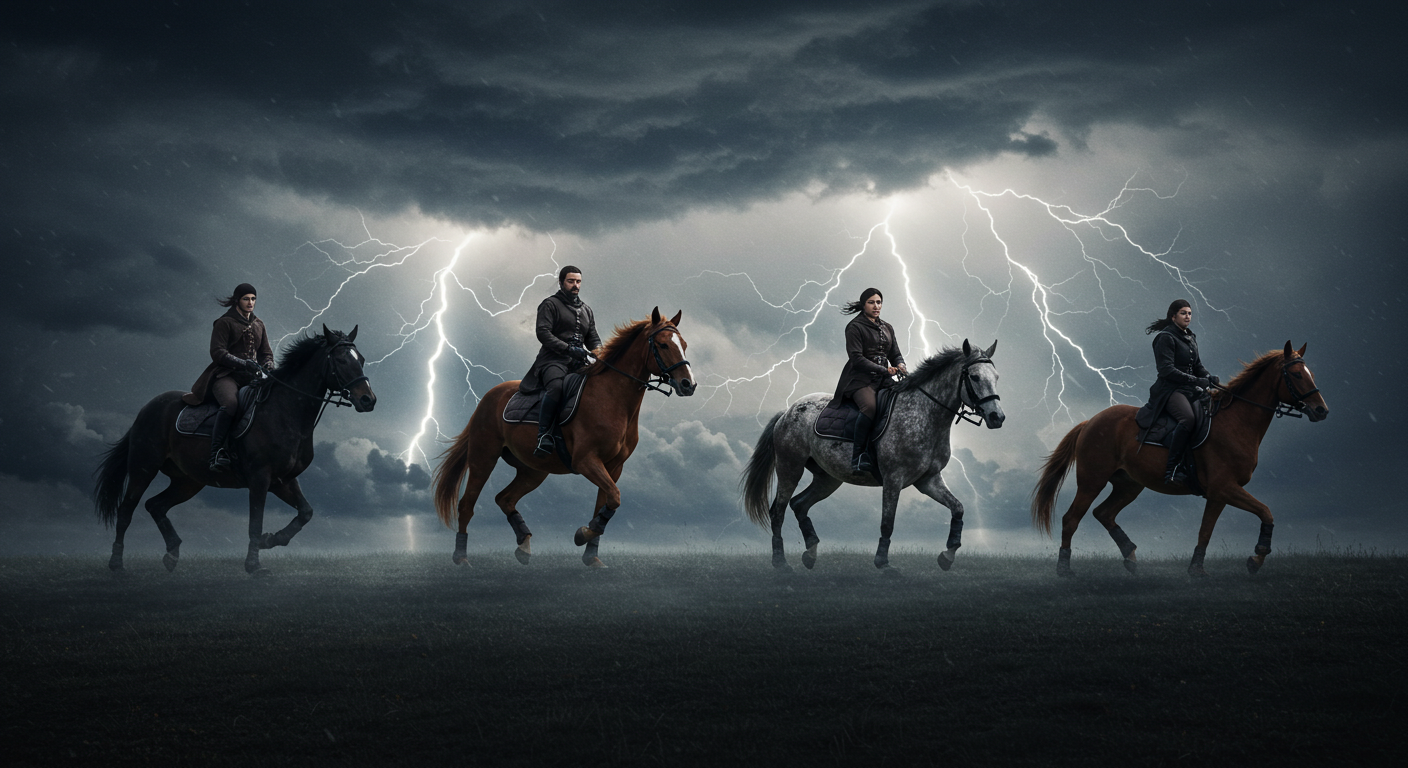
The first rider: The White Horse
When you study the four horsemen of the apocalypse, the first rider is the one you can easily miss if you rush. In the text, he rides a white horse and carries a bow; he is given a crown and rides out to conquer. Read the description: Revelation 6:1-2.
Many interpretations exist. Some see this rider as Christ, because elsewhere Christ is portrayed with a white horse (see Revelation 19). Others see him as a false messianic power or a deceptive conquest—a conquest that promises peace and unity but brings domination. When you read the passage pastorally, consider both: a legitimate kingdom claiming victory and a counterfeit that mimics Christ’s triumph but lacks sacrificial love.
Symbolic breakdown of the white rider
The crown suggests authority or claim to authority. The bow suggests martial power or conquest—especially without a sword, hinting at strategy or deception. Its appearance first is significant: false peace or deceptive leadership often paves the way for greater turmoil. For you, the white rider is a reminder to test claims of peace and power against the Gospel’s character.
The second rider: The Red Horse
The second of the four horsemen of the apocalypse is perhaps the most direct in its symbolism: war. Read the text: Revelation 6:3-4. The rider on the red horse is given a large sword, and he takes peace from the earth so that people kill one another.
This rider represents escalation—when conflict replaces dialogue and human systems resort to violence. Historically and presently, war breaks communities, shatters families, and brings deep trauma. But Revelation frames it within a larger theological story: war results from human rebellion under judgment and the distortion of God’s good gift of authority.
Symbolic breakdown of the red rider
The red color connotes blood and violence. The sword is a straightforward symbol of war. You should notice the text links cause and effect: peace removed, killing follows. When you read about this rider, it’s not only a warning about external conflict but a caution about the violence that lives in human hearts and societies. The pastoral question becomes: how will you promote peace where conflict threatens?
The third rider: The Black Horse
You’ll find the next rider on a black horse carrying scales. The text reads: Revelation 6:5-6. The voice among the four living creatures speaks of the price of wheat and barley, and the economic squeeze is stark: basic food is available, but luxury suffers. This rider symbolizes economic distress, famine, and inequality.
The black horse points to the way scarcity affects people differently. The scales are a market image—weights and measures—implying rationing or economic control. But the passage also communicates moral truth: greedy systems and unjust distribution result in suffering. Economies can be instruments of both blessing and harm.
Symbolic breakdown of the black rider
The use of scales suggests calculation: who gets enough and who goes hungry? The cost-of-living detail is painfully realistic. For you, the black rider is a call to compassion and justice. It asks how you will respond to the hungry, the poor, and those crushed by unjust economics.
The fourth rider: The Pale Horse
Finally, the fourth of the four horsemen of the apocalypse is the rider on the pale horse, named Death, followed by Hades. Read the solemn words: Revelation 6:7-8. This rider has authority over a fourth of the earth to kill by sword, famine, plague, and wild beasts—a broad catalogue of death-dealing forces.
The pale horse consolidates the effects of the other riders: conquest, war, and economic devastation culminate in widespread death. The pairing with Hades emphasizes that death is not an isolated event but a realm of ongoing consequence. The passage paints a somber picture of human vulnerability and the reality of mortality.
Symbolic breakdown of the pale rider
“Pale” (chloros) evokes sickness and decay. The comprehensive list of causes of death—sword, famine, plague, wild beasts—underscores the multifaceted nature of mortality. Theologically, the rider points to the brokenness of creation under sin and the reality that death will hold sway until Christ’s final victory. Spiritually, it urges you to live in hope and prepare for eternity.

How to interpret the four horsemen
Different interpretive frameworks yield different emphases when reading the four horsemen of the apocalypse. None of these will do all the work alone; most readers combine insights. Here are the major approaches you’ll encounter and what they offer you.
Preterist approach
Preterists read Revelation as largely fulfilled in the first centuries of the church—especially in events like the fall of Jerusalem and Roman persecution. From this view, the riders may symbolize real crises faced by early Christians: political pretenders, civil war, economic hardship, and plagues. This approach helps you see Revelation as immediate pastoral encouragement to people in crisis.
Historicist approach
Historicists see Revelation as a sweeping panorama of church history from John’s day until Christ’s return. The four horsemen might then represent recurring patterns—periods of conquest, warfare, famine, and death—that recur across centuries. This view helps you see God’s sovereign plan across the flow of history and the persistence of these destructive patterns.
Futurist approach
Futurists place most of Revelation’s events in the end times, anticipating a sequence of global disasters immediately preceding Christ’s return. For you, the futurist reading intensifies the urgency of watching and readiness but can sometimes fuel anxiety if not balanced by pastoral assurance about God’s control.
Idealist (symbolic) approach
Idealists read Revelation as symbolic of the ongoing spiritual realities and struggles between good and evil. The four horsemen, in this view, are archetypal images of human sin and cosmic brokenness that appear in every age. This approach highlights timeless spiritual truths: sin’s consequences, the fragility of peace, economic injustice, and mortality. It helps you apply Revelation’s lessons to your daily discipleship.
Eclectic practical approach
You may find the most helpful path is eclectic: honor the original historical context, take seriously the prophetic and future dimensions, and apply the passage as a living, spiritual word for today. No matter your interpretive preference, remember John’s pastoral aim: to sustain hope and call the church to faithfulness.
The theological core: judgment, sovereignty, and hope
When you look past the vivid images, three theological pillars hold the passage together: God’s judgment, God’s sovereignty, and God’s promise of ultimate victory.
- Judgment: The riders operate within God’s permissive will or under divine judgment. Revelation stresses that God is just. The consequences seen in the vision are not random; they are bound up with the fallen state of the world and human rebellion.
- Sovereignty: Even the riders are under the Lamb’s authority. The sequence begins when the Lamb opens seals; he is the one who unfolds history. This is theologically crucial: suffering does not indicate divine absence but is contained within God’s sovereign plan.
- Hope: Revelation’s purpose is to assure the faithful. The dramatic imagery points to a final restoration. The picture of suffering is real but never ultimate.
For you, these truths mean that while evil and suffering are present and painful, they don’t have the last word.
Common misconceptions about the four horsemen
As you study the four horsemen of the apocalypse, you’ll run into misconceptions that unhelpful producers of fear or confusion often spread. Here are a few to watch out for.
- Misconception: The four horsemen are only about future end-times dates you can calculate. The biblical text resists precise timetables and instead calls for watchfulness and faithful living.
- Misconception: Revelation’s imagery is meant purely to terrify. The book’s pastoral aim is to comfort and encourage endurance.
- Misconception: The horses represent only supernatural beings. While spiritual agency may be involved, the riders also symbolize social, political, and economic realities rooted in human choices.
Challenging these misconceptions will help you engage with Revelation maturely and faithfully.
Historical and cultural background that shapes the imagery
When John wrote Revelation, the Roman Empire’s power, brutality, and imperial cult loomed large. Images of conquest, forced tribute, and famine were living realities. Symbols like crowns, swords, and scales would have immediately connected with the lived experience of John’s original audience.
Understanding that background helps you see why the four horsemen hit so deeply: they reflect the ways imperial power crushes people, how war and economic exploitation devastate communities, and how death stalks ordinary life. For you, knowing the background grounds your interpretation and breaks the claim that Revelation is mere fantasy.
The pastoral application: what this means for your life
Reading about the four horsemen of the apocalypse is not an abstract exercise; it has very real pastoral implications for how you live your faith now.
- Stay spiritually alert: Jesus warns you to watch and pray. Revelation calls for vigilance rooted in trust, not panic.
- Serve the vulnerable: The imagery highlights human suffering. You’re called to help feed the hungry, pursue peace, and support those in crisis.
- Test false peace: Be discerning about leaders and movements that promise easy solutions or coercive security. Contrast their claims with the Gospel’s ethic of sacrificial love.
- Hold onto hope: The Christian hope is not naive. It acknowledges suffering while anchoring you in the promise that Christ’s final victory makes all things right.
When you apply these principles, Revelation becomes a source of spiritual formation, not merely speculation.
Practical ways you can respond
You can put your faith into practice in concrete ways: volunteer at a food bank, promote conflict resolution in your community, engage in honest civic conversation, and care for those who grieve. Your actions testify to a God who cares for justice and mercy.
How the four horsemen relate to the rest of Revelation
The four horsemen are part of a larger unfolding: seals, trumpets, bowls, and the final cosmic drama. The sequence shows escalation, but each stage serves to call the church away from complacency and toward faithfulness. You’ll find the themes of judgment and redemption recur throughout Revelation.
The book ends not with unending doom but with a vision of a new heaven and new earth. That final hope reframes how you read the four horsemen: they are part of the narrative that culminates in the restoration of all things under Christ.
Responding to fear and curiosity
It’s natural to feel both fear and curiosity with apocalyptic imagery. Here’s how you can respond constructively:
- Ground your curiosity in Scripture: read the passages yourself, such as Revelation 6:1-8, and engage with trustworthy commentaries.
- Avoid sensationalism: prioritize interpretation that fosters faith and practical love rather than excitement.
- Pray for wisdom: ask God to shape how you live in a world marked by brokenness.
Your faith is strengthened by sober study and faithful action, not by chasing every headline.
Frequently asked questions
You will have questions, and some of the most common include: Are these riders literal beings? Are they future events or recurring patterns? Do they predict our generation specifically? Briefly: the text supports symbolic reading, historical resonance, and future implications. Which emphasis you adopt will shape how you live, but all faithful readings point to God’s control and the call to perseverance.
If you want a direct scripture reference that shows Christ ultimately conquers, read Revelation 19:11-16. That vision places the earlier images into the horizon of God’s final victory.
Wrap-up: living in hope while watching faithfully
When you wrestle with the four horsemen of the apocalypse, remember that John’s goal is pastoral: to help you stand firm. The riders are stark reminders of sin’s consequences and the fragility of human institutions, but they are set within the sovereignty of the Lamb. Your call is to live with courage, to love your neighbor, and to keep your eyes on Christ—the one who has gone before you to redeem suffering and finally bring justice.
Read the primary passage carefully: Revelation 6:1-8. Let it shape your heart toward compassion and watchfulness, not despair.
Explore More
For further reading and encouragement, check out these posts:
👉 7 Bible Verses About Faith in Hard Times
👉 Job’s Faith: What We Can Learn From His Trials
👉 How To Trust God When Everything Falls Apart
👉 Why God Allows Suffering – A Biblical Perspective
👉 Faith Over Fear: How To Stand Strong In Uncertain Seasons
👉 How To Encourage Someone Struggling With Their Faith
👉 5 Prayers for Strength When You’re Feeling Weak
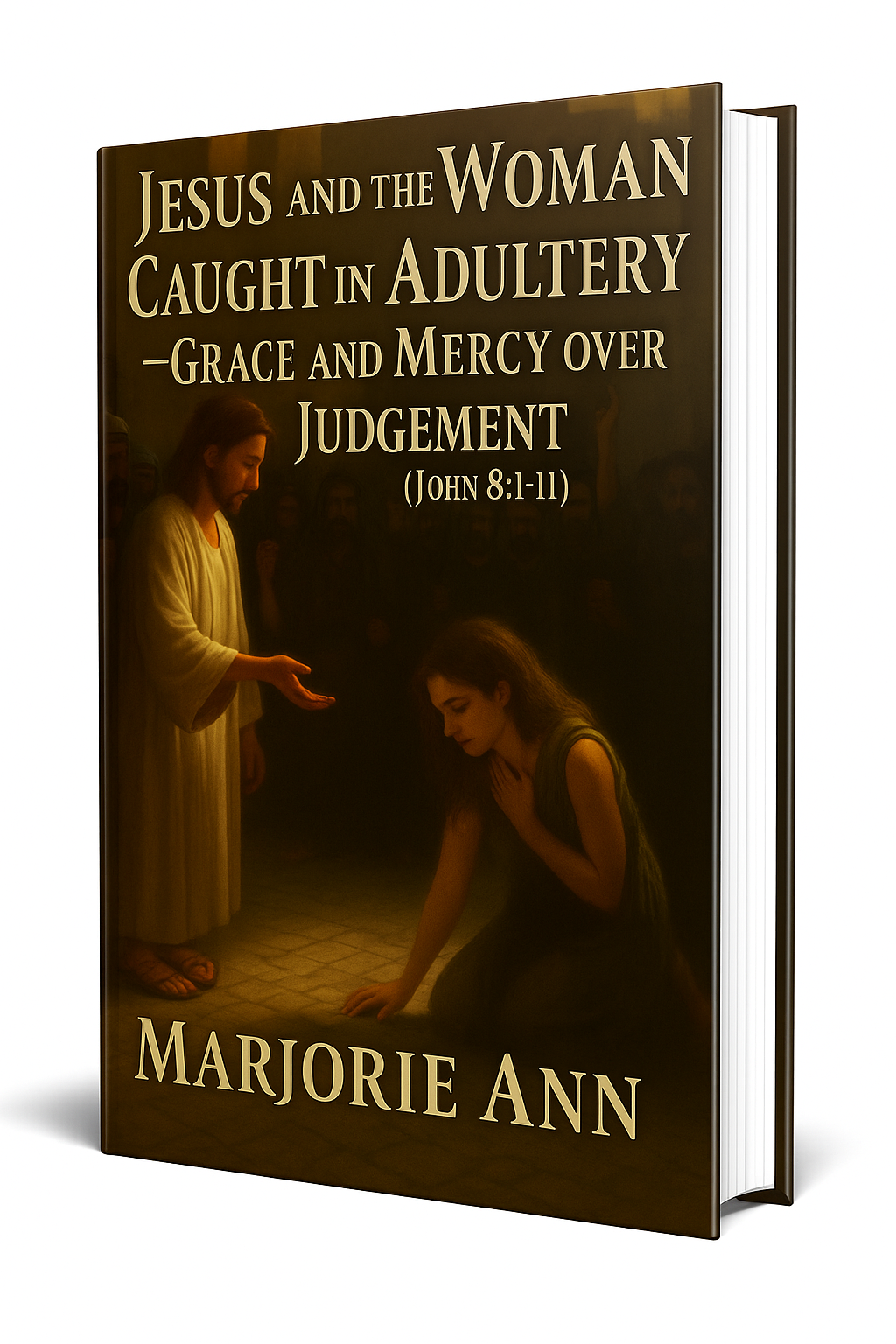
📘 Jesus and the Woman Caught in Adultery – Grace and Mercy Over Judgement
A powerful retelling of John 8:1-11. This book brings to life the depth of forgiveness, mercy, and God’s unwavering love.
👉 Check it now on Amazon
As a ClickBank & Amazon Affiliate, I earn from qualifying purchases.
Acknowledgment: All Bible verses referenced in this article were accessed via Bible Gateway (or Bible Hub).
“Want to explore more? Check out our latest post on Why Jesus? and discover the life-changing truth of the Gospel!”



